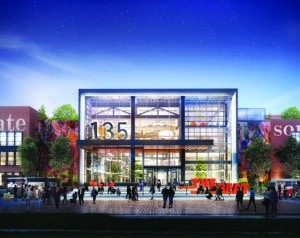
Stantec’s design for the adaptive reuse of the former Boston Globe headquarters enabled 80 percent of the building’s existing materials to be retained, reducing landfill waste and improving LEED ratings. Image courtesy of Stantec
To reach carbon neutrality, both new and existing buildings must address operational and embodied carbon. Existing buildings represent a prime opportunity by prolonging the life of used materials and creating a venue to cut operational emissions.
Architecture 2030 research shows the building sector is the largest global greenhouse gas source at approximately 40 percent of global emissions, with materials and construction representing 11 percent. Prolonging the useful life of materials already in place offers an immense opportunity to curb these emissions, especially through materials with high embodied carbon such as steel, concrete and masonry.
This reduces the need for virgin materials and, potentially, helps shorten construction schedules while curbing existing greenhouse gas emissions. Lending credence to the saying that “the greenest buildings being those already existing,” it’s important the real estate industry consider adaptive reuse over new construction where possible.
Helping to BEAT Climate Change
In Stantec’s design of The BEAT, the former Boston Globe headquarters property in Dorchester, we salvaged more than 80 percent of the existing building, substantially reducing demand for new materials, while curbing landfill waste – all aspects of the project’s pending LEED certification. Additionally, this upgrade triggered opportunities to meet modern energy codes, relocate critical HVAC systems above the flood zone and incorporate Americans with Disabilities Act upgrades to make the site more accessible and equitable.
Demolition is expensive and time consuming, while adaptive reuse can often support cost savings and reduce construction time. Since The BEAT involved an existing structure within the same FAR and envelope, with minimal exterior upgrades, the team was able to expedite a building permit because the project required fewer design review meetings. Additionally, building improvements were looked upon favorably by the city of Boston and community, due to the transformation from industrial to commercial use, reducing traffic and noise. Furthermore, incentives for historically significant structures, where applicable, can also help make a business case for adaptive reuse.
Reusing existing buildings and sites also creates opportunities to improve community connectivity. The BEAT no longer separates the adjacent community from the nearby transit hub. Its redesign, open on three sides, facilitates tenant and pedestrian activity at grade through the addition of amenities like cafes, gyms and green space. The building catalyzes future development by establishing a pedestrian corridor to reconnect this vital link to the metropolitan area.
Rebuilding on the Fly
Many buildings simply cannot shut down, even if pursuing significant upgrades. In such cases, phased renovations must be employed. It is important to consider life-cycle implications of properties when undertaking partial/phased renovations to maximize the money and time spent.

Blake Jackson
For example, when replacing a building’s rooftop, it may also be advantageous to consider replacing dated HVAC&R equipment or adding solar photovoltaic panels. Another advantage is the ability to slowly transform a building, which spreads capital investment out over several years and budget cycles.
Our work on a confidential multifamily project is taking this approach and provides a template for optimizing renovations over time. Over the next decade, Stantec will work with ownership to renovate this prototypical Back Bay residential building floor by floor to minimize tenant displacement. Phase one will transform the top floor into an amenity and leasing level. The addition of a new roof offers the chance to create a new terrace with an event space, indoor and outdoor seating, pool and solar array – all modern elements lacking in many existing buildings, which can refresh and add value to existing structures and keep their desirability high.
Existing buildings play a vital role in the history of a place and the memory of its people. The term “preservation” often conjures images of very old buildings or historically significant structures; however, all buildings deserve this consideration.
Stantec’s Fort Point location at 311 Summer St. is one such building. This 1911 warehouse was adapted into the city’s first LEED Platinum offices in 2009. The lofty brick and timber construction, tall operable windows and open floor plates enhance collaboration and promote well-being, gaining Fitwel certification in 2017. The location within the lively Fort Point district also further connects the occupants to the rest of the city and its rich history through its preservation and use.
Black Jackson is sustainability design leader at Stantec.




 |
| 
